[Editor’s Note: Benjamin Fisher is a development worker formerly stationed in Central Java, Indonesia. In finding a desire to learn more about this specific topic Ben discovered a vacuum for a general guide to stingless beekeeping, particularly in his context. The following resource is an effort on his part to consolidate information on stingless beekeeping in a palatable, readable format for those in Southeast Asia—and most specifically for those on the island of Java. The compiled information seeks to create an overview and introduction—not an extensive reference guide. Sources for further reading have been included below.]
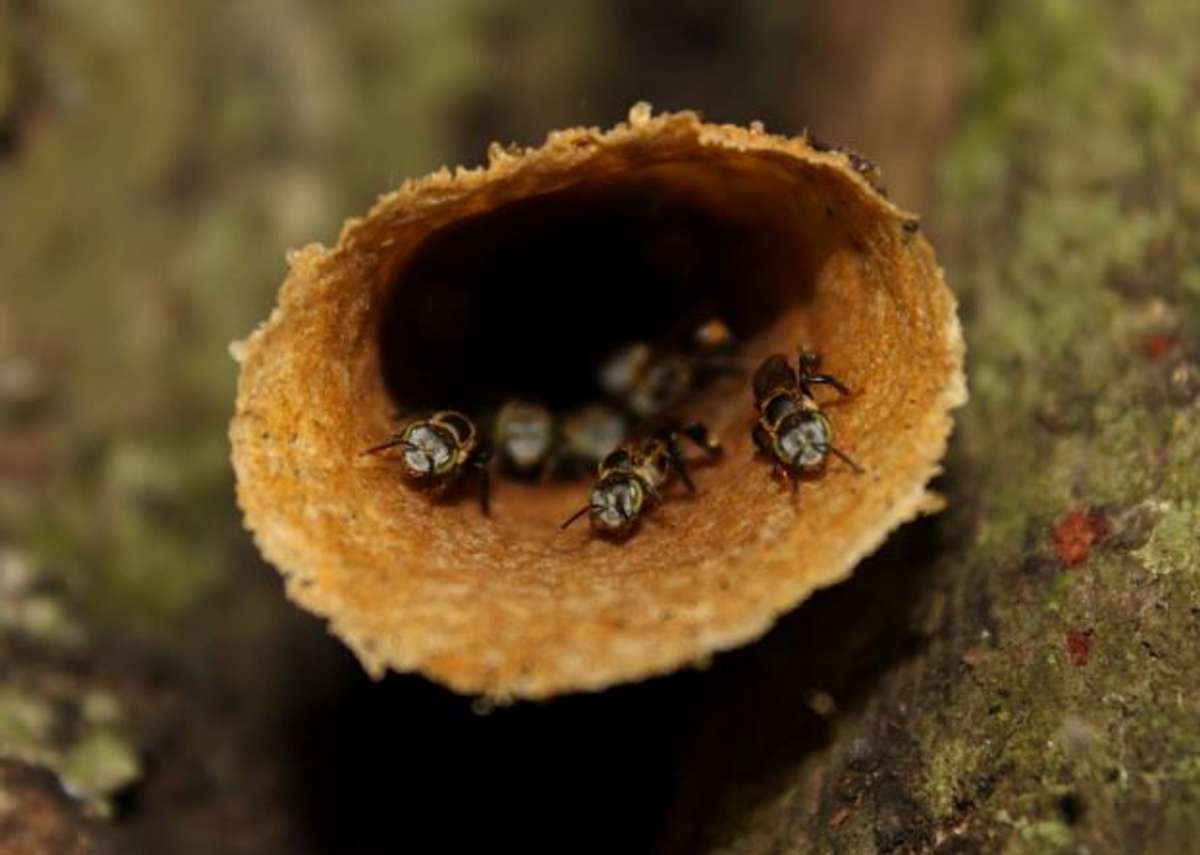
Introduction
Stingless Beekeeping, or Meliponiculture, is the keeping of bees from the tribe Meliponini. Stingless bees comprise hundreds of species with there being a possible 89 confirmed species in Subtropical/Tropical Asia and Australia alone (Rasmussen, 2008); and, while many are able to produce honey, they are a completely different Tribe of species from domesticated honey bees (Apis mellifera and Apis cerana indica). While stingless bees do still have stingers, they are small and underdeveloped, rendering them unable to sting a person—which is how they earn their namesake. They are, however, still able to bite (though by some accounts: not painful) and will try and irritate the honey robber by attacking the eyes or ears. Stingless bees have been kept for thousands of years, most notably in the New World Tropics, where there were no honeybees before their introduction by European colonists and explorers. Stingless bees have received much less attention in the form of research and development than honeybees due to a number of factors.
Stingless bees produce a honey that is higher in water content than honey produced by domestic bee species. With domestic species the water content is typically below 20% when it is harvested; whereas the honey of many stingless bees is around 30% on average: though it can range depending on the species from 20-45%. The higher water content in the honey means that it undergoes a natural fermentation process—so most stingless bee honey has a sour tang to it most likely caused by acetic acid (vinegar) or lactic acid produced through the fermentation process. This fermentation process occurs due to the presence of microbes like yeast and bacteria—many of which are probiotics. This higher water content means that stingless bee honey can spoil and should be pasteurized if a longer shelf life is desired. There are also many claimed health benefits and some research showing that these claims may be substantiated— including possible anti-diabetic properties through protection of the pancreas. The honey of stingless bees generally is sold for a higher price than honey from domesticated honey bees (Aziz et al., 2017).
Some species of stingless bees will only produce up to two kilograms of honey a year while the rest produce even less. This is significantly lower than the yields from domesticated honey bee hives—which is one reason for the higher price per kilogram of honey. Stingless bees also tend to visit a larger range of flowers than domesticated honey bees: though some of this is explained due to the great number of species as research shows that different species will visit flowers of specific plant families.
Most stingless bees do not make hexagonal cells out of beeswax like honey bee species do. They use plant resins to make propolis—a compound also made by honeybees and known generally as ‘Bee Glue.’ The propolis made by stingless bees tends to be higher in wax than propolis made by honeybees and is therefore sometimes referred to as cerumen. This material is used to encapsulate the honey in small ‘pots’ (Figure 2); and also serves to seal holes, create other structures within the hives, and to entomb invasive dead animals too large for the bees to remove (i.e. mice, other larger insects, etc.). The propolis tends to be dark in color, can be harvested, and can be utilized by man in a number of ways. It can be used to create a kind of varnish for staining wood, it can be used in some cosmetics, and it has a number of proven and claimed health benefits if consumed. Propolis has been shown to be anti-viral and anti-bacterial. There is also research that shows that propolis may be effective in the fighting and prevention of cancer. Here in Indonesia I have been told that propolis is used medicinally as well and is prescribed for cancer patients.
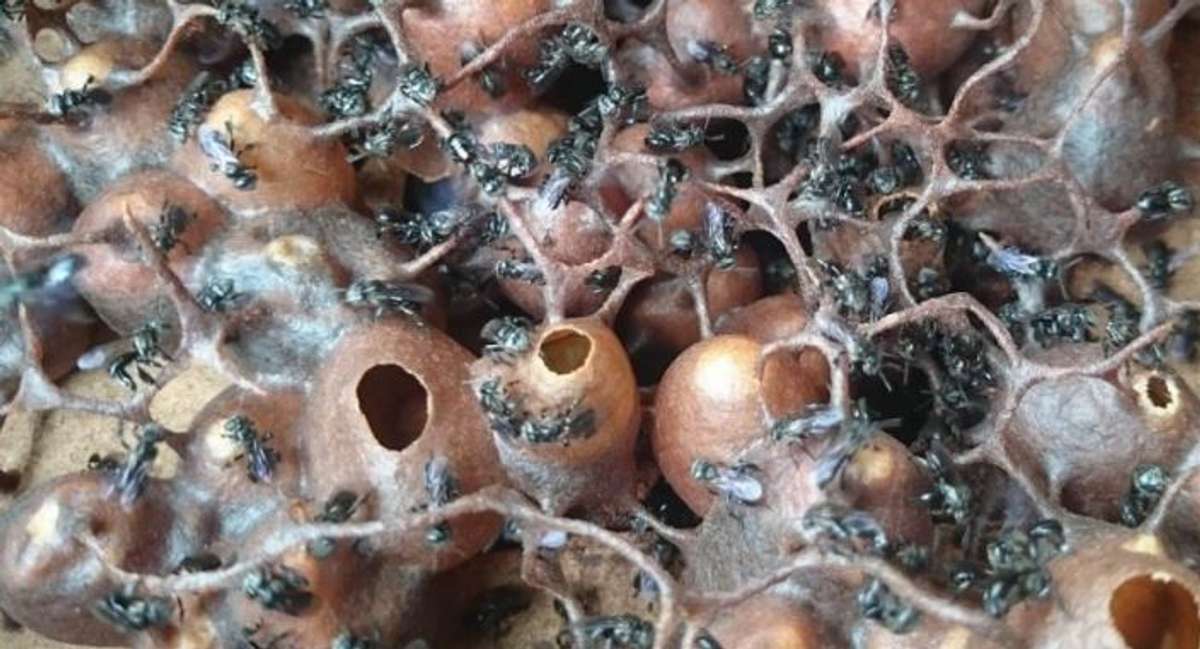
Figure 2. Close-up look of a stingless bee hive structure for Heterotrigona itama.
[Editor’s Note: For questions, comments, or personal experience on this topic visit the echocommunity ‘conversations’ forum Meliponiculture: Stingless Beekeeping.]
Stingless Bees on Java
There is differing information on how many stingless bee species are present on the island of Java. The only information I could find online claimed that there could be six to nine (or more) species on Java: but only proceeded to list six. These species include: Geniotrigona thoracica, Heterotrigona itama, Lepidotrigona terminata, Tetragonula drescheri, Tetragonula laeviceps, and Tetrigona apicalis (Pangestika et al., 2017).
These bees all vary in size with the largest workers belonging to the species Heterotrigona itama and Tetrigona apicalis, both being a little more than 5 mm in length, with the primary noticeable difference between the two being the bicolored wings of T. apicalis. In the figure below (Figure 3) we can see a comparison of three stingless bee species—all present on Java—side-by-side with the Asian domesticated honey bee. The bees I have the most experience with I believe to be T. drescheri but currently I am unsure: this species is considerably smaller than all the above species. Many of the stingless bees we have here are mistaken for small flies or for gnats—to put things into perspective on their size.

Some of these species can be found on other Indonesian islands as well; and, some can even be found in other areas of Southeast Asia: including Cambodia, Malaysia, and Singapore. There are also some species found in Indonesia that are found as far away as India. I plan on contacting a university located in Bogor, Indonesia (a city near the capital—Jakarta—on the island of Java) in order to try and acquire more information on known species on the island of Java due to the lack of information I can find online (in English or in Indonesian).
Colony Capture and Hive Structure
As may be inferred by the size of the bees and amount of honey available to harvest, stingless bees tend to construct hives much smaller than domesticated honeybees. Most of the time—with stingless bees here on Java—their hives are found in bamboo culms, wood, stone or brick walls, or really any small hollow. There are a number of methods for capturing these wild colonies in order to transfer them to a man-made hive for use in households or farm systems.
The primary method used in transferring wild hives into man-made systems is a very simple one. When a wild hive has been discovered an assessment should be made as to how easily the wild hive can be captured; for example: is the hive imbedded in scrap wood, bamboo culm, or manmade plastic or metal container? If so, removal of the hive simply involves the opening of the housing material. Specific components of the hive are then removed and placed within the new, man-made hive.
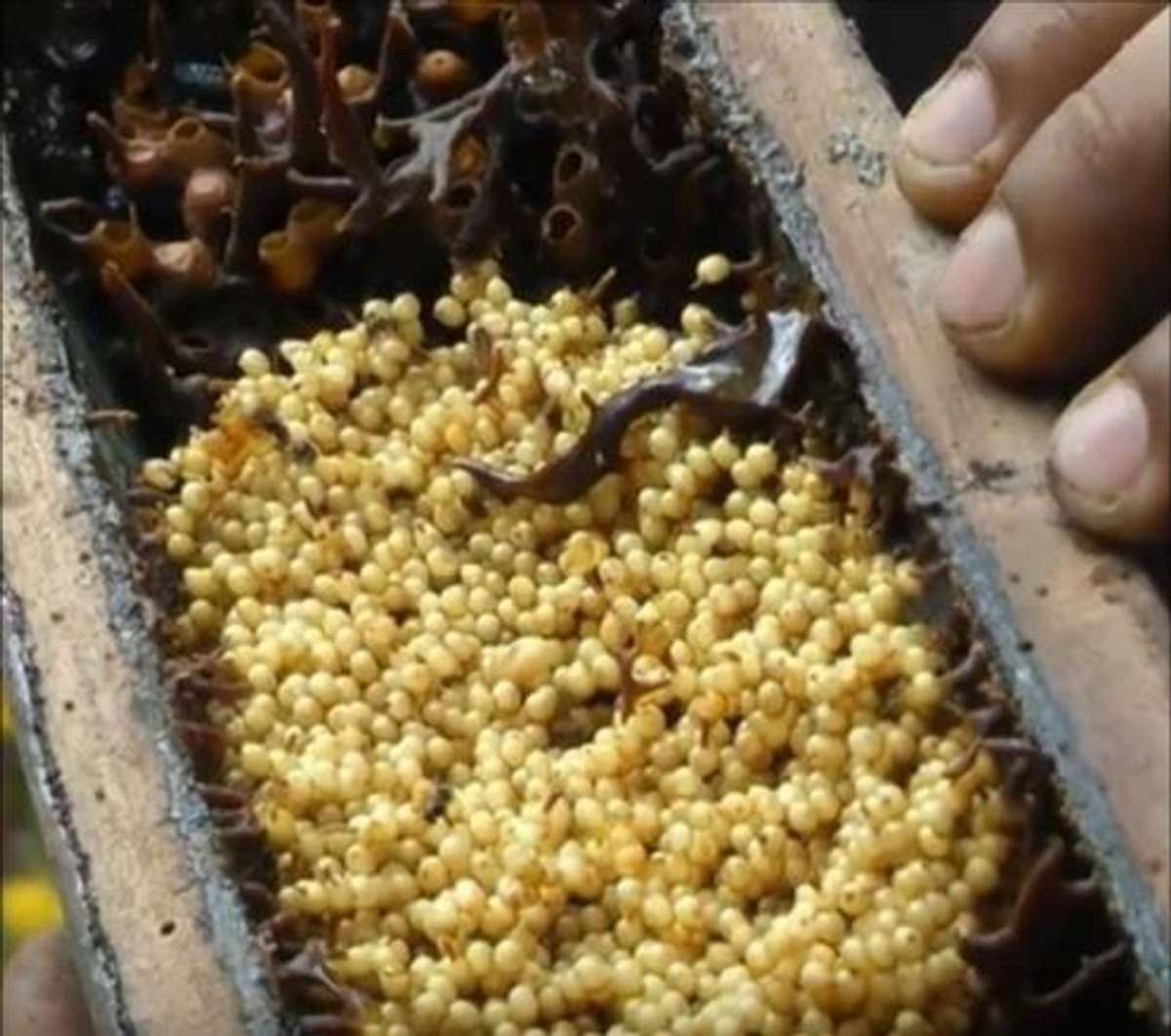
In the above picture (Figure 4) we see an example of hive structure from inside of a man-made, simple, wooden hive. The layout is very similar to the layout of a honeybee hive with the primary difference being that the structure is made of propolis instead of wax. The entrance of this particular hive is found towards the top of the picture (not in view). The structures are being used to store pollen—a protein food source for the larvae. The white cells shown in the picture, which represent the next structure in the hive, are cells containing bee larvae that are near maturity and are referred to as ‘brood cells’ in both stingless bee hives and honeybee hives (Figure 4). The cells tend to be darker in most species if they contain younger larvae—the white cell denoting that the containing ‘brood’ are near pupation. It takes around 35-50 days for the cell to produce a bee depending on the species.
The third, and final, structures in the hive are the ‘honey pots.’ This is the area where the stingless bee honey is stored and tends to be the farthest away from the entrance. Like honeybees, this behavior can be exploited through the use of honey ‘super’ structures with queen excluders. Super structures are the divisions in man-made hives and honey supers are structures made to contain only honey. The exclusion of brood cells is achieved through the use of a queen excluder. With both honeybees and stingless bees the queens are larger than worker bees. This means that structures can be built that are large enough to allow worker bees through—who of course are carrying the honey—but small enough that the queen cannot enter. If the queen cannot enter than there will be no brood in that section of the hive: as it is the queen who lays the eggs into the brood cells.
The nature of some species of stingless bee’s hives and reproduction means that there could be a mature, living queen and either one or two queen cells with larval queens; or even a mature queen with one or two virgin queens. This means that two or three hives can be established from one single wild hive. Each man-made hive needs a portion of the pollen, brood, and honey structures from the original colony.
When removing a hive from a more permanent structure that cannot practically be opened, like a rock, concrete, or brick wall, the process becomes more drawn out. The primary process (which can apparently be used for honeybees as well) is to seal the entrance of the hive and allow only one opening via a tube or hose that then connects to the back of the man-made hive. This tube needs to be between 30 and 50 cm. in length. The purpose of the hose is to create a path that creates a new entrance via the entrance of the man-made hive. The bees will begin using the hose as a path to exit the hive and will begin to move into the man-made structure because of convenience and proximity to the hive entrance. This process of moving can take anywhere between six months to a year. The reason for the extended period of time is because the previous brood has to mature and become adult bees before the queen will move to new brood cells in the man-made hive. Below are examples: all the information about hive removals from walls and the following pictures are from the video titled Stingless Bees Part 2 – Getting Bees out from a Wall (Binu, 2016).
We are currently in the process of testing this wall removal method out as this source is based out of Kerala, India—which means the specifications used may not apply to our local species. I am currently unaware of any methods for hive removal from walls in Indonesia. The hive removal pictures at the top of this section were also taken from the same source of videos based out of Kerala, India; but, when compared to lesser quality video captures in Indonesia (particularly one in Central Java where we are) do not appear to be any different from the ones depicted in India.
There are some general rules to keep in mind when capturing or splitting a hive. Just after capturing or splitting a hive, the hive is vulnerable to attack from ants. Some methods for guarding against ants will be included in the Hive Design section. Split hives should also be kept close to each other initially (within 30 cm). Both the captured hives and the split hives should be placed (in the man-made hive) close to the original location and should remain there for about one month. Something to keep in mind when moving brood to a man-made hive is that white cells are stronger than brown cells. Propolis also tends to attract stingless bees—this can be used to the keeper’s advantage by putting propolis around the entrance to the new hive in order to lead wayward workers to the new location. Another tip, if the colony is located within a wooden structure to be opened, it may be useful to collect as many of the colony members as possible before opening up the hive. This can be done by placing a breathable container for capture over the entrance and then tapping on the hive to aggravate the bees into defending. The container will fill up and the bees can then be placed aside in a shady area. This can be of benefit because it will decrease the overall number of bees that can be injured during the removal process and also lessens the number of bees that can attack or pester the bee keeper.
Hive Designs
There are a number of hive designs I have found in my research when looking at keeping stingless bees in Southeast or South Asia. These include but are not limited to: natural hives with coconut shell honey supers, various wooden box designs, bamboo hives, and a PVC hive. I have seen photos taken in Central and South America where they will construct hives out of earthenware, so that is potentially a possibility as well. I also am aware that there are stingless bee hives that are kept in hollowed logs (Figure 5).
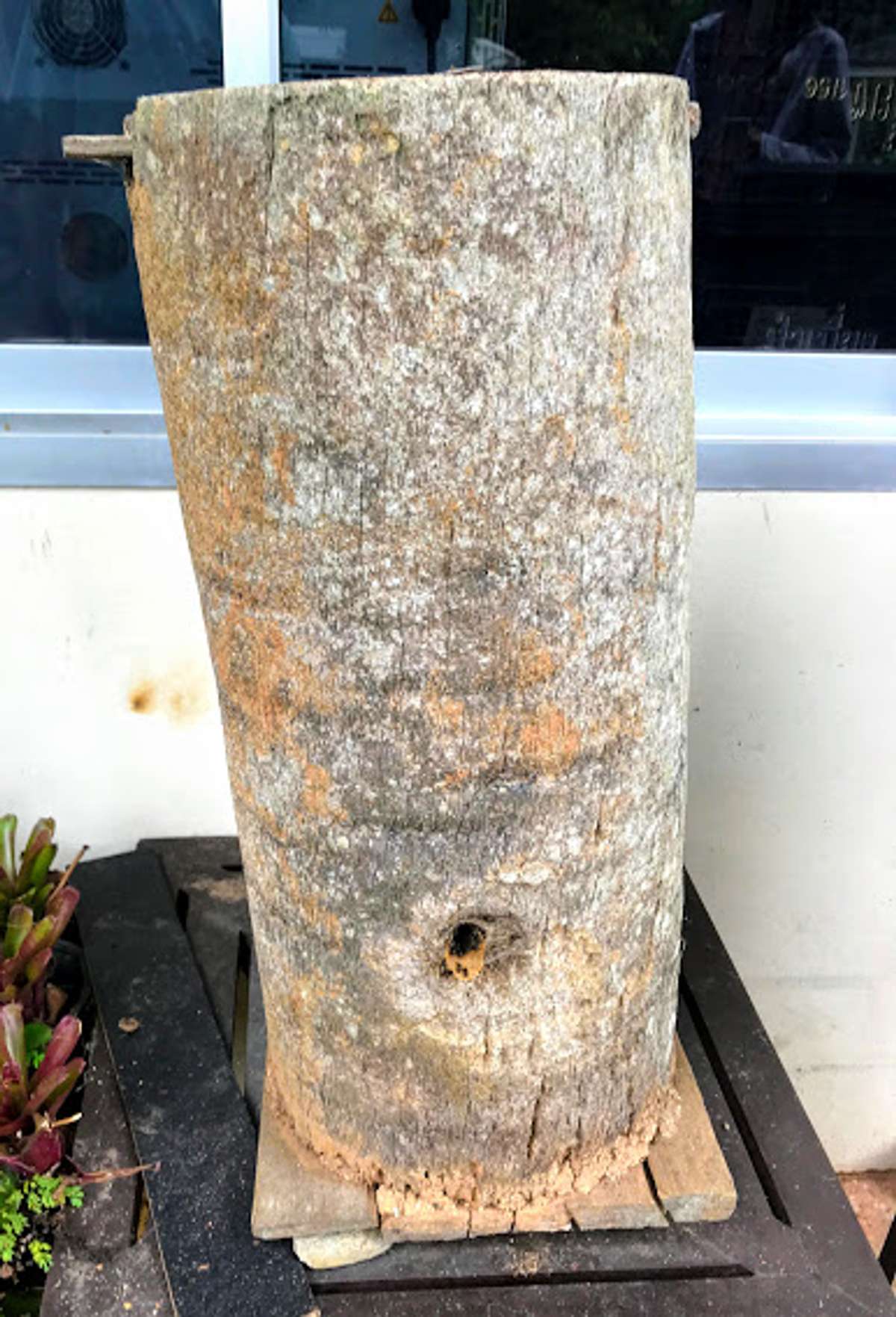
Wooden Box Hives
The first and most common man-made hive that I am aware of is a wooden box hive. This is currently one of two systems I have seen in Indonesia and is what I have seen in videos from other Southeast Asian and South Asian countries as well. A box hive can be as simple as it sounds: a wooden box with a small hole as the entrance. Typically, the boxes have a removable lid or the box can be split in two. Many of the hives I have seen actually stay closed and sealed by using the propolis made by the bees. Typically these boxes range in volume from 1-4 liters. The optimal size of the hive is determined by the bee species—as stingless bee species range significantly in individual size and hive size.
Some designs also incorporate a clear plastic sheet between the lid and the hive in order to allow for scouting. This is possible because the bees will attach propolis to the plastic instead of the hive lid which allows for easy removal of the lid and gives the keeper the ability to observe the hive. This allows the keeper to know when to harvest and allows them to assess the health and progress of the hive.
Other systems I have seen incorporate two chambers within the wooden box. This is typically done by stacking two boxes that attach to one another. These systems typically incorporate a queen excluder (mentioned earlier in the document). These excluders are typically just a wooden board with a single or multiple holes drilled into them. This sort of system allows for the removal of half of the hive without disrupting the brood and typically will decrease the amount of damage done to the hive when honey is harvested. This will also lessen damage to juvenile bees. On the next page is an example design for a wooden box hive as provided by the FAO (Bradbear, 2009) (Figure 6). This design is specifically from documents focused on Meliponiculture in the Philippines, but because of proximity there are probably some species shared across the Philippines and Indonesia. This design includes vent holes—which is a feature I haven’t seen on any other systems so far. This design is also fairly close to designs I have seen of Australian hives—which tends to be where most English information on stingless beekeeping comes from. My primary hesitancy with using information from Australian sources is how different their stingless bees tend to seem from Javanese stingless bees.
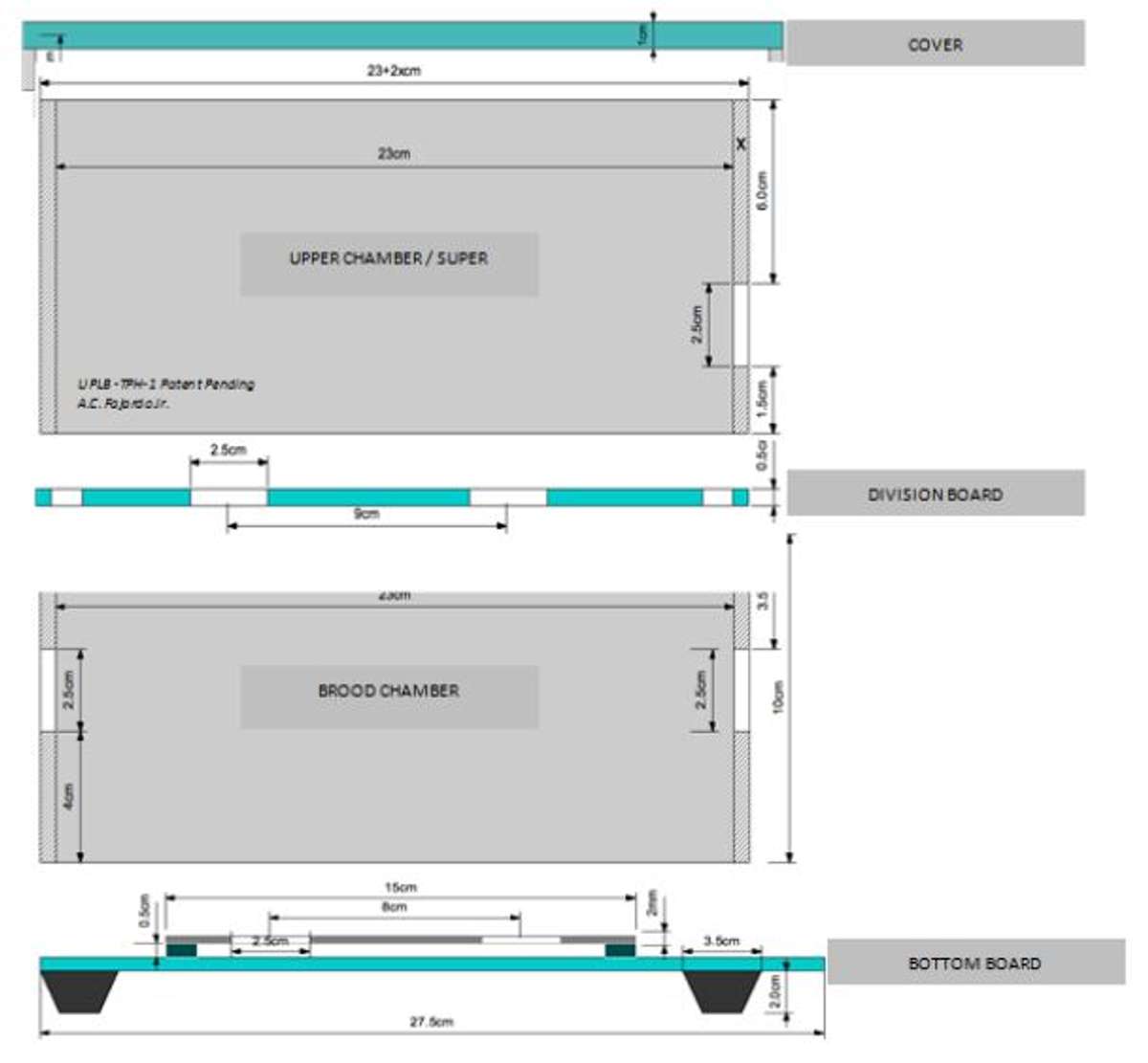
Bamboo Hives
The bamboo hives that I have seen tend to be some of the simplest hives that I am aware of. The bamboo hives are basically comparable to the simplest kinds of box hives. These hives are made by simply splitting a chamber of bamboo lengthwise and drilling a small hole in one of the sides (Figure 7). A hive is then placed inside and the two halves of bamboo are fastened together using materials like wire or spare propolis. Harvesting from these hives tends to be very invasive and damage is inevitable done throughout the hive; however, this is probably one of the cheapest and most labor efficient ways to make a hive.
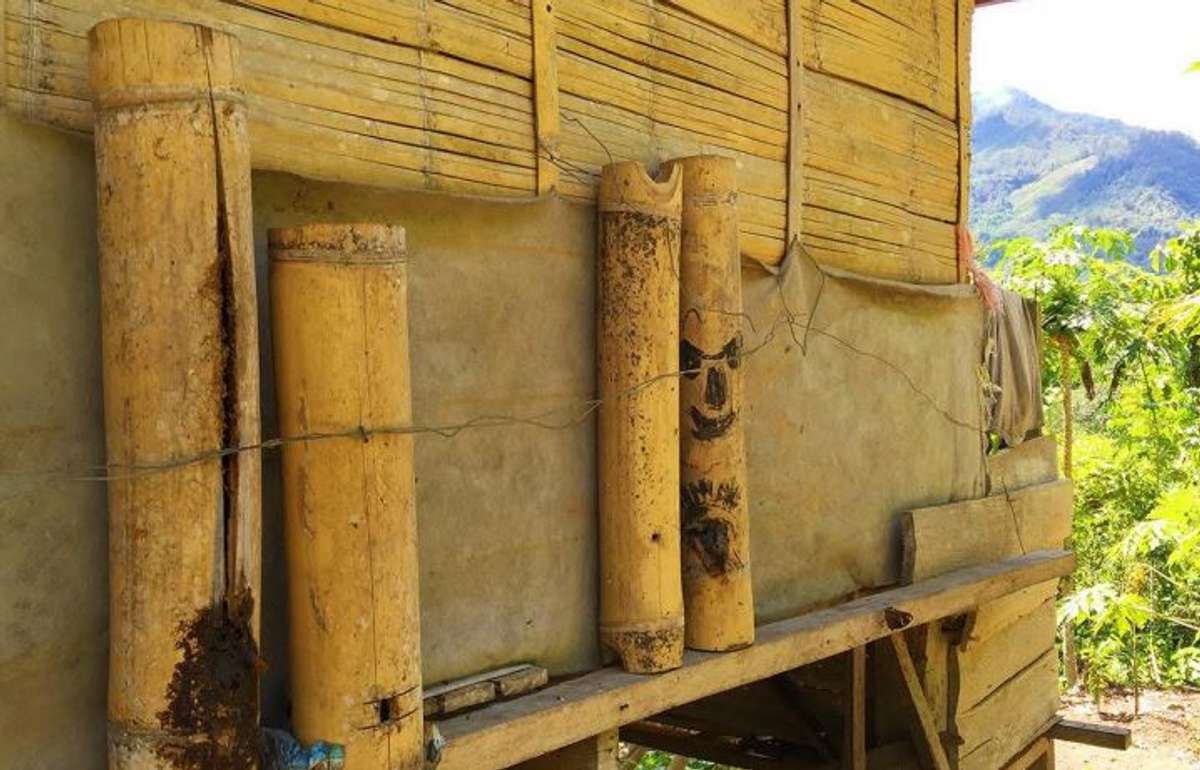
Coconut Hives
There are two primary designs that I know of regarding the use of coconut shells (excluding the husk). One method is the use of a coconut for the entirety of the hive. This sort of hive system is amongst the oldest of the man-made hives but has a number of issues, including the need to destroy the majority of the hive in order to access the honey. This is only appropriate for certain species as well because the interior of a coconut is pretty limited in volume. However, there is a way to tweak this system which I will discuss in the next paragraph.
The other use for coconuts that I am aware of is a system that is practiced in the Philippines. There they use the coconuts as a honey super—basically using it as an addition to a hive for the storage of honey. This can be done by either attaching the coconut to an existing, wild hive; or the coconuts can be used as a honey super for a coconut hive. These sorts of systems are also very labor efficient in construction and make use of a common waste material found throughout the tropics. Coconut shells also have the benefit of being very rot resistant which will help with the longevity of the hive structure.
PVC Hives
We have only seen systems using mostly natural and cheap materials. The following system is one that is promoted by a farm in Kerala, India known as Madhusree Honey Farm. While this system is not made of cheap, natural materials; it is made of readily available, longlasting materials at a reasonable price. The parts for this hive should be available at any store that sells plumbing parts and supplies.
The benefits of this hive are not only the durability and longevity of the hive, but also the ability to customize using prefabricated materials. The system that will be discussed shortly allows for the quick and easy access and harvest of the honey with minimal stress to bees and damage to the nest. The other major benefit of this hive is the ability for it to be hung up in various locations. This helps to protect the hive from predators and allows for greater use of space as the hive could be hung off of a building, a tree, etc. This hive design should hopefully be appropriate for bees on Java considering one design is used for multiple bee species in Kerala, India—which shares at least one species with Indonesia.
All of the following images are provided by the videos found on the Youtube channel Work With Nature regarding Madhusree Honey Farm and their specific PVC hive system—invented by the founder of the farm (Binu, 2016).
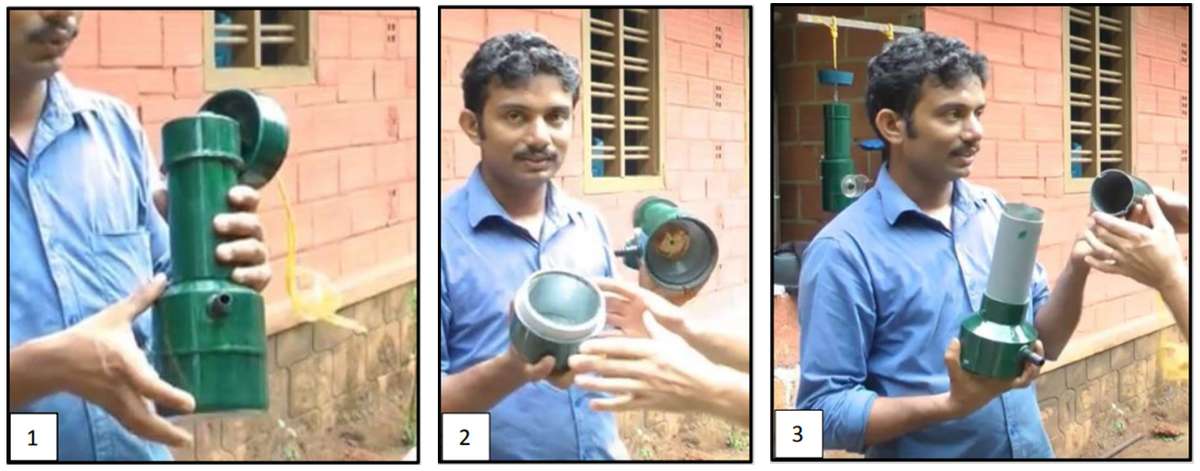
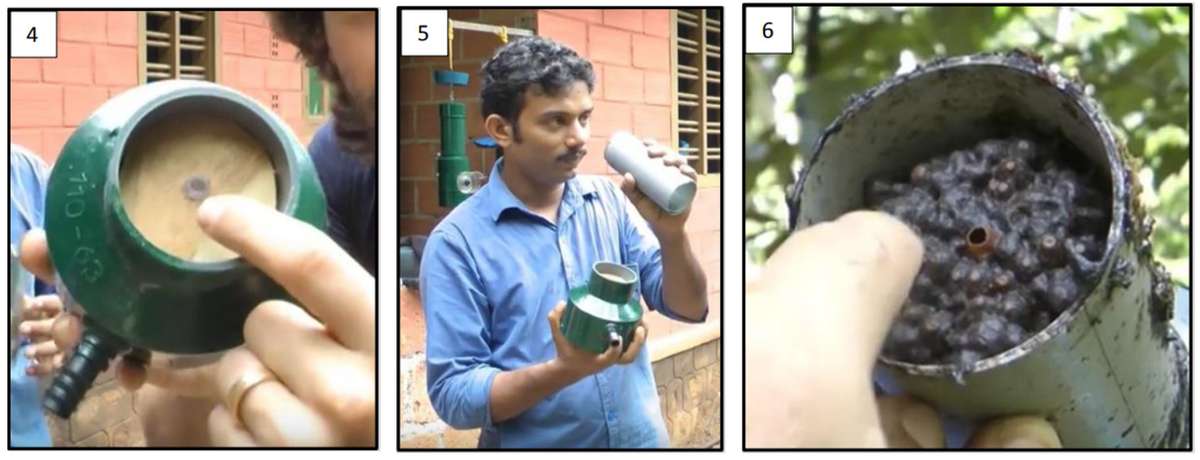
Ant Control
The final topic of this document will be a short discussion on ant control. As stated before, when a hive has recently been split, moved, or harvested from the bees are, for a time, vulnerable to attack from pests like ants. The primary system for keeping ants away is through a number of ‘moat’ designs: this is the most practical because ants will not cross over a liquid like water or oil. If you have a hive on a small table or anything with ‘legs’ then the solution can be quite simple: you merely put each leg or post into something like a coffee can (or other container) and fill the can with water or oil. Of course, the leg or post should not be in contact with the sides of the can for this to work.
In the case of a hanging hive, typically some sort of modification should be created for the rope or wire that attaches the hive to its perch. This modification typically has to hold water for it to work. Other options for preventing attacks from ants include rubbing a sticky or slick substance around the upper housing of the honey super or around the rope/wire used to attach it to its perch. This can include things like Vaseline or fly paper. The final suggestion for a hanging hive is to hang it with fishing line. Fishing line is difficult for ants to grasp and can help protect the hive. The line has to be a thicker gauge in order to hold the weight of the hive.
Resources
Aziz, M.S.A., Giribabu N, Rao P.V., Salleh N. 2017. Pancreatoprotective effects of Geniotrigona thoracica stingless bee honey in streptozotocin-nicotinamide-induced male diabetic rats. Pubmed. https://www.ncbi.nlm.nih.gov/pubmed/28222394
Binu, P.T. 2016. Stingless Bees/Meliponiculture Part 1 – Designing the Beehives and Getting the Honey! Work With Nature. Nov. 13, 2016. https://www.youtube.com/watch?v=Av43ZiQP1UQ&list=PLhAXjvNqBVlOCeJ8sr8n_bK0nOYAQzOv&index=1+14
Binu, P.T. 2016. Stingless Bees/Meliponiculture Part 2 - Getting Bees out from a Wall! Including the Queen! Work With Nature. Nov. 20. 2016. https://www.youtube.com/watch?v=EvbnWpLWFFQ
Bradbear, N. 2009. Bees and their role in forest livelihoods. A guide to the services provided by bees and the sustainable harvesting, processing, and marketing of their products. Chapter 6: Meliponiculture of Stingless Bees. Foof & Agriculture Organization of the United Nations. http://www.fao.org/3/i0842e/i0842e00.pdf
Rasmussen, C. 2008. Catalog of the Indo-Malayan/Australasian stingless bees (Hymenoptera: Apidae: Meliponini). Zootaxa 1935. https://www.researchgate.net/publication/271214026_Catalog_of_the_Indo-MalayanAustralasian_stingless_bees_Hymenoptera_Apidae_Meliponini
Pangestika, N.W., Atmowidi, T., and Kahono, S. 2017. Pollen load and flower constancy of three species of stingless bees (Hymenoptera, Apidae, Meliponinae). Tropical Life Sciences Research 28(2):179–187. doi: 10.21315/tlsr2017.28.2.13